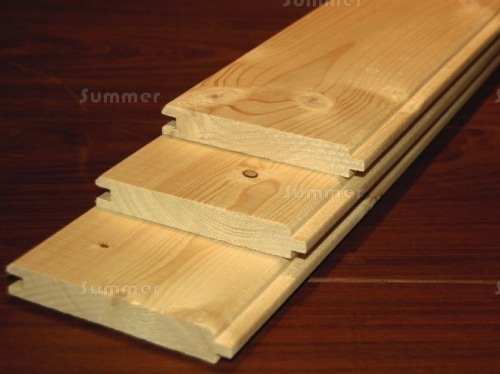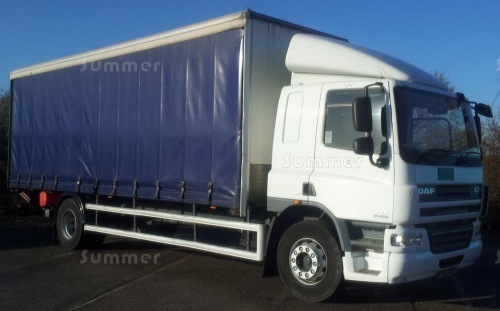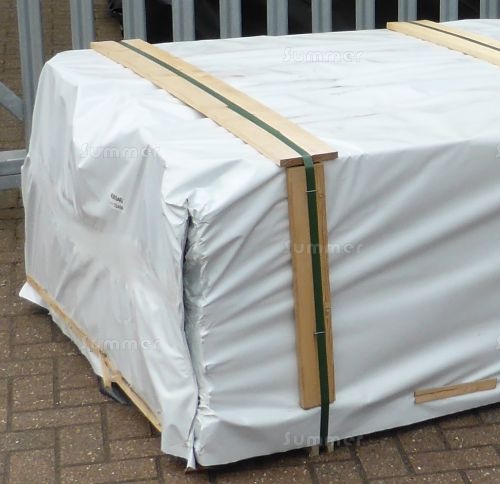Click this messge to hide it.
This useful guide contains information and advice about all aspects of your delivery. Please take a few minutes to read it. Also, please print it or save it on your computer for future reference. You should also have received our Important Product Information with comprehensive advice and useful tips to help you enjoy your purchase to the full. Please contact us if you have not received it.
CONTENTS
Scroll down or click on the links below:
- PALLET DELIVERIES - Log Cabins and Large Gazebos
- PALLET DELIVERIES - Optional Crane Delivery
- PALLET DELIVERIES - The Lorry
- PALLET DELIVERIES - The Pallet Network
- PALLET DELIVERIES - Planning Your Delivery
- PALLET DELIVERIES - The Driver
- PALLET DELIVERIES - The Delivery
- PALLET DELIVERIES - Unloading the Individual Components
- PALLET DELIVERIES - Storage
YOUR PALLET DELIVERY - LOG CABINS AND LARGE GAZEBOS
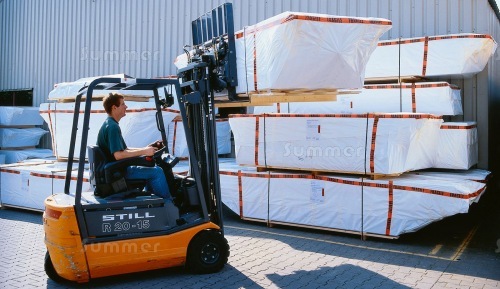
- Log cabin packs are up to 6 metres long (20ft) and weigh up to 2 tonnes (2000kg). That is longer and heavier than most cars.
- Even the smallest log cabin packs are around 3 metres long (10ft) and weigh around 750kg.
- Many of our larger wooden gazebos are also delivered in very similar packs.
- Large pallets over 1.6m long are too large to be unloaded quickly and easily with a hydraulic tail lift and a pallet truck.
- We offer next day delivery with any log cabin or gazebo which is in stock.
- We do not have all sizes and all models in stock all of the time.
- Your order includes our standard pallet delivery, which is ideal if you want a fast delivery or a specific delivery day.
- Your order includes next day delivery on any weekday of your choice, using a national pallet distribution network.
- Next day delivery is available throughout mainland England, Wales and Southern Scotland.
- Delivery is within 3-5 days in Northern Scotland.
- Options include AM delivery, PM delivery, delivery at a specific time and Saturday delivery.
- You can also request a phone call shortly before delivery, which saves people waiting around on site.
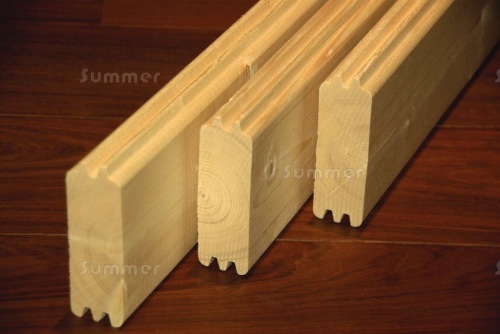
- Pallet networks do not operate lorries with a crane so the pallet needs to be unloaded by hand, piece by piece.
- Our pallet delivery service is especially popular with customers who want to install the building themselves.
- By the time you finish unloading and checking your delivery you will know every component.
- At most properties the pack is unloaded at the front. It often needs to be moved into the back garden after delivery which takes longer than the unloading.
- Unloading by hand is not difficult if you are fit and strong. We have arranged thousands of large pallet deliveries.
- A small 10'x10' (3x3m) log cabin includes less than 200 pieces of wood, plus the doors and windows.
- A large 16'x16' (5x5m) log cabin includes less than 300 pieces of wood, plus the doors and windows.
- We recommend 2 fit and strong people to unload which normally takes around 30 minutes.
- The driver normally helps to unload and most are very helpful. However, we cannot control this as the driver is not our employee.
- If you do not want to unload by hand please contact us - we can often upgrade you to a crane delivery.
OPTIONAL CRANE DELIVERY
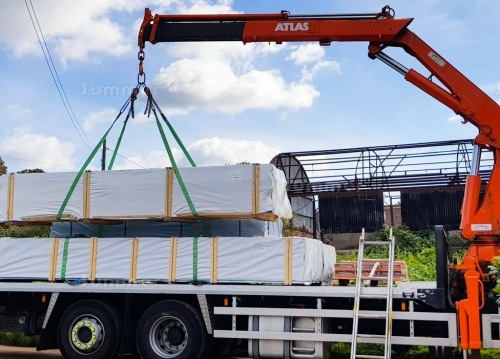
- Our crane delivery service is the easiest way to have your log cabin or gazebo delivered.
- Lorries with a truck mounted crane can unload large pallets quickly and easily in one piece with no hand unloading required.
- At most properties the driver can unload the pack without assistance in about 15 minutes.
- At most properties the pack is left on the drive, often along one side of the drive so it is out of the way.
- Occasionally it is possible to hoist the pack over a wall or hedge and place it next to the base, which may save a lot of time.
- Crane deliveries are normally arranged as part of a full load with up to 6 log cabins, all in the same area.
- We normally deliver stock log cabins and gazebos with a crane within 2 to 4 weeks of order.
- Crane deliveries are slower than pallets and you cannot choose a specific day, but no hand unloading is required.
- Our crane delivery service is especially popular with customers who are paying somebody else for installation.
- Fitters normally require a few weeks notice which nullifies the benefits of a next day pallet delivery.
- Fitters expect to move the individual components from the front of the property. This is normally included in their price.
- At most properties the unopened pack can be stored somewhere for a few days. If so, you can save the stress and effort of unloading by hand and also the extra task of moving the components afterwards.
- Ideally the pack is delivered a few days before the installation starts and remains unopened until the fitter arrives.
- Our crane delivery service is available as a low cost option throughout England, Wales and Southern Scotland.
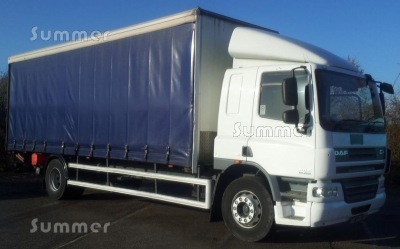
PICTURE: A typical pallet delivery lorry.
THE LORRY
- The delivery vehicle is normally a rigid lorry around 10m (33ft) long with curtain sides.
- The lorry is approximately the same length as 2 cars parked in line, but please allow 3 car lengths for manoeuvering.
- The back of the lorry is normally around 8m (27ft) long.
- Please advise if lorry access is difficult at your property.
- Reasonable access to your property and parking directly outside is assumed.
- Please advise if there are any low bridges, narrow bridges, weight limits, width limits, parking restrictions, unloading restrictions or narrow lanes at or near your property.
- Our lorry is bigger than a large bin lorry. Please advise if a large bin lorry cannot easily park outside your property.
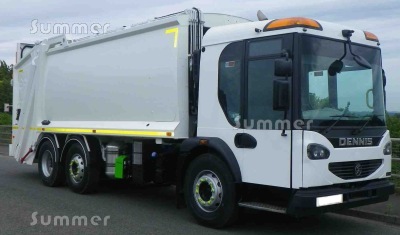
PICTURE: A large bin lorry.
The back of the lorry is normally around 8m long, which is long enough for our largest packs.
The pack is half the width of the truck and fits along one side of the lorry.
The driver will ensure that the lorry is facing in the right direction for unloading.
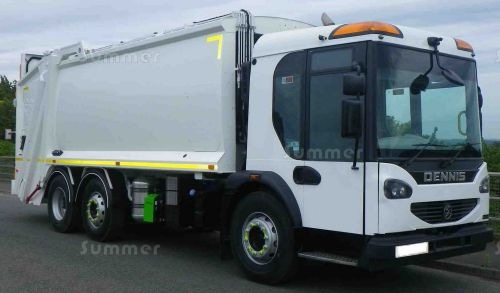
THE PALLET NETWORKS
The only way we can deliver our pallets throughout the UK within a day or two is using national pallet networks. The service is better than the parcel networks we use for smaller deliveries, with fewer delays and much less damage. The vast majority of pallets are delivered on time and intact, but not all of them. If you are one of the unlucky ones we can only apologise and try to resolve the problem. It can be very annoying if a delivery is late or damaged. Unfortunately we cannot operate without the national pallet networks and we cannot change them. Although it does not solve anything we thought it may help you to understand a little about how they operate:
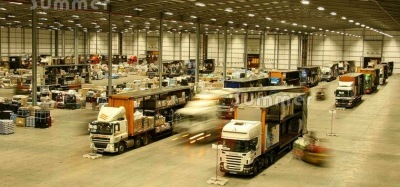
PICTURE: The central hub of a national pallet network late at night, full of pallets and trunkers being loaded and unloaded.
- National pallet networks are normally based on a bicycle wheel structure, with one central hub and lots of spokes, each leading to a local depot.
- Every day each depot collects pallets from within its own local area, which are delivered to the central hub that night.
- After each trunker lorry has been unloaded at the hub, it is loaded with pallets which need to be delivered by that depot in its local area on the following day.
- Early the next morning, the trunker lorries return to the depot with all of the pallets their depot needs to deliver that day in their local area.
- The pallets are then loaded into smaller lorries, each of which delivers and collects within a small patch of the local area.
- The local depot based near us in Norwich collects from us every day and delivers your pallet to the central hub.
- The final stage of the journey is delivery to you by your local depot.
- Every day two national networks collect pallets from our warehouses.
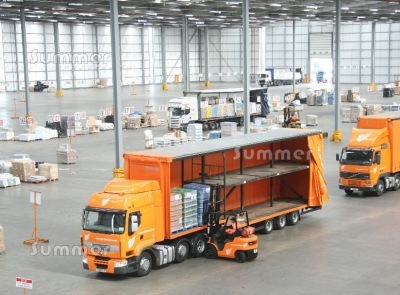
PICTURE: A network hub in the early hours, with fewer trunkers to process and most of the pallets already on their way.
- Damage is far less frequent than parcel networks because each pallet occupies its own space on the lorry.
- The pallets are picked up by forklifts and pallet trucks with no manual handling.
- With each pallet picked up and set down a minimum of eight times as it travels through the network, there is always a chance of damage or routing errors.
- Although the service for pallets is more reliable than parcels, on busy nights the networks do not always have enough space on the lorries for every pallet to every area. If a backlog develops overnight it may not be cleared until the next day and some pallets may be delayed by a day.
- Occasionally on the busiest nights the hubs are overwhelmed. This means there are more pallets than the network can deliver on the following day, so some pallets are delayed. Most delayed pallets follow on a day later than expected.
- The busiest night every week is often Thursday night, with extra pallets wanted by domestic customers on Friday for use at the weekend.
- The busiest nights of all are the night before a bank holiday weekend.
- It is not possible to forecast the spikes in demand with any degree of certainty. For example, when the sun comes out far more people buy garden products.
- The best way to avoid the rush is to order a few days earlier.
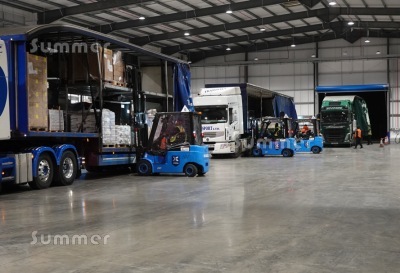
PICTURE: Articulated double decker trunkers deliver to and from the network hubs each night.
- The majority of pallet deliveries are business to business.
- Domestic pallet deliveries have grown fast in recent years, primarily due to national online retailers of bulky products, such as us.
- Most business to business deliveries are completed effortlessly within a few minutes, because most businesses have a forklift and easy access for lorries.
- The drivers get to know each business on their patch and often collect or deliver every day from the same premises and the same industrial estates.
- Occasionally, business to business deliveries are awkward if the business has no forklift or if lorry access is difficult. To deal with this, many of the pallet lorries feature a hydraulic tail lift, which allows the driver to unload the pallet quickly and easily without assistance using a manual pallet truck. It is this aspect of the pallet service which we utilize.
- Domestic deliveries are more challenging due to restricted lorry access at some addresses, properties with no drive, drive surfaces which are unsuitable for pallet trucks and customers who are away at work on weekdays.
- Our logistics team are expert at overcoming any obstacles.
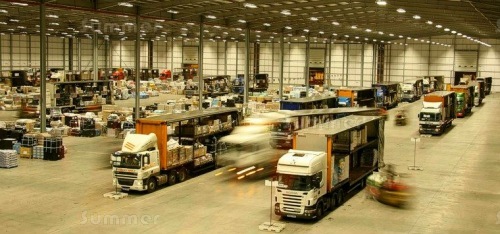
PLANNING YOUR DELIVERY
- Our popular “book in” service is free. It is similar to a time specific delivery except it is a minimum 3 day service. Your pallet is delivered to your local depot who phone you to agree a convenient day and time for delivery.
- We are sometimes asked to deliver a pallet on a smaller vehicle. This is normally possible but only with notice when your local depot has a smaller vehicle available. This service is free but it may delay the delivery by a day or two.
- We are sometimes asked if the pallet can be delivered on a crane lorry. Unfortunately crane lorries are specialist vehicles which pallet distribution companies do not use. A crane delivery is only possible if you upgrade your order.
- Local farmers and businesses with a fork lift are often happy to help unload with advance notice if asked.
- Estimated arrival times are approximate. Journey times are unpredictable due to variable traffic and delays with other deliveries.
- If asked we will add notes requesting specific times to avoid, for example if you have a dental appointment.
- We recommend simple instructions because the pallet networks are sub-contractors. We do not know your local depot or the driver.
- Be on the look out for a telephone call on delivery day. The driver may be lost and trying to contact you.
- Delivering large pallets is expensive. You can postpone delivery at any time up to the day before delivery. However, you should not cancel or postpone the unloading on the day of delivery as this may incur expensive re-delivery charges. You should unload the pallet whatever the weather even if one of your helpers fails to arrive.
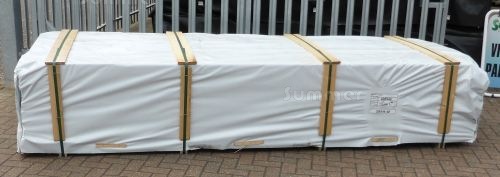
THE DRIVER
- The drivers are hourly paid and rarely concerned if unloading is slow. Their boss may be more concerned so we recommend that you start unloading promptly and keep unloading steadily without stopping.
- Most drivers are fit and strong and happy to help with unloading. However, this is not certain. They are employed as drivers and not obliged to undertake physical work. It is up to each driver. We have no control over this because the driver is not our employee. We recommend that you organize enough people to unload without assistance from the driver, just in case.
- You are not obliged to pay the driver for helping you to unload. It is entirely at your discretion. Most drivers will help you anyway. Also, if you have enough helpers you do not need any help. Not all drivers are fit or keen on physical work. We recommend that you evaluate your driver before offering any incentive.
- The driver should not allow unloading to start unless he or she is confident that it will be unloaded quickly. You may need to reassure the driver.
- If you requested a phone call before delivery which did not take place it follows that your helpers may not arrive in time and unloading may be slower as a result. If so, it would be difficult to justify a charge for waiting time.
- A driver who is in a hurry would help you unload. If your driver did not help you unload, it would be difficult to justify a charge for waiting time.
- Always check before climbing on the back of the lorry and reassure the driver that you will be careful. The driver should be concerned about the health and safety of anybody on the vehicle.
THE DELIVERY
- Unless you ordered an AM, PM or time specific delivery, the delivery could be any time between 9am and 5pm.
- Pallet networks normally allow up to 30 minutes to complete each delivery, after which waiting time is payable.
- In practice waiting time charges are extremely rare, especially if the unloading is only a few minutes late.
- Customers and local drivers have advised that unloading sometimes takes longer than 30 minutes but always less than 60 minutes.
- If possible find helpers who are fit, strong and happy to put in some physical work for around 30 minutes.
- Remember too many helpers makes unloading quick, easy and fun but too few people could be stressful.
- It is always advisable to get along with the driver, which may help if you are running late.
- If asked the driver may agree to extend your unloading time by having a break at your property, if a break is due.
UNLOADING THE INDIVIDUAL COMPONENTS
- The picture above shows the inside of a log cabin pack with the wrapping removed and the individual logs exposed.
- To open the pack normally requires a sharp knife. A claw hammer may also be required.
- You will need thick and tear resistant gloves. Always wear gloves when handling timber.
- A dmall step ladder may also be useful to access the top of the pack when it is on the lorry.
- First cut the straps to open the pack.
- Some packs feature timber outer framing which needs to be carefully removed first.
- Any polythene covering should also be completely removed to expose the components.
- Most of the components are individual pieces of wood weighing 5-10kg which can be unpacked one or two pieces at a time.
- We recommend 2 people to unload the largest items safely.
- The heaviest components are the windows and doors.
- The glass is often factory fitted, which reduces damage but it means the doors and windows are heavy.
- The windows and single doors are often supplied in one piece, fully assembled in the frame and ready for installation.
- Double doors are often broken down into two separate door leaves with the door frame in separate pieces.
- Other heavy components include triangular front and rear gables supplied with apex roof cabins. Gables are often supplied in one piece for easier installation. Disposable battens which hold the gables together during handling are removed after installation.
- Other heavy components include prefabricated roof panels, which are sometimes supplied with smaller hexagonal, octagonal and pyramid roof buildings.

STORAGE
- We recommend using the pallet at the bottom of the pack to store the components. It was tailor made for the job, providing a stable platform and preventing direct contact between the components and the ground.
- Be careful in hot or sunny weather to store timber components in a shady spot or, if possible, inside a garage or outbuilding. In strong sunlight long pieces of timber can bow or twist and smaller pieces can shrink significantly, even if covered. To counter this, place heavy items on top of the components such as any roofing supplied including felt tiles, steel tiles or cedar tiles. Heavy garden furniture may also be suitable.
- If your order includes floor and roof insulation this can be placed on top of the components. Insulation is the ideal material to protect timber components from strong sunlight.
